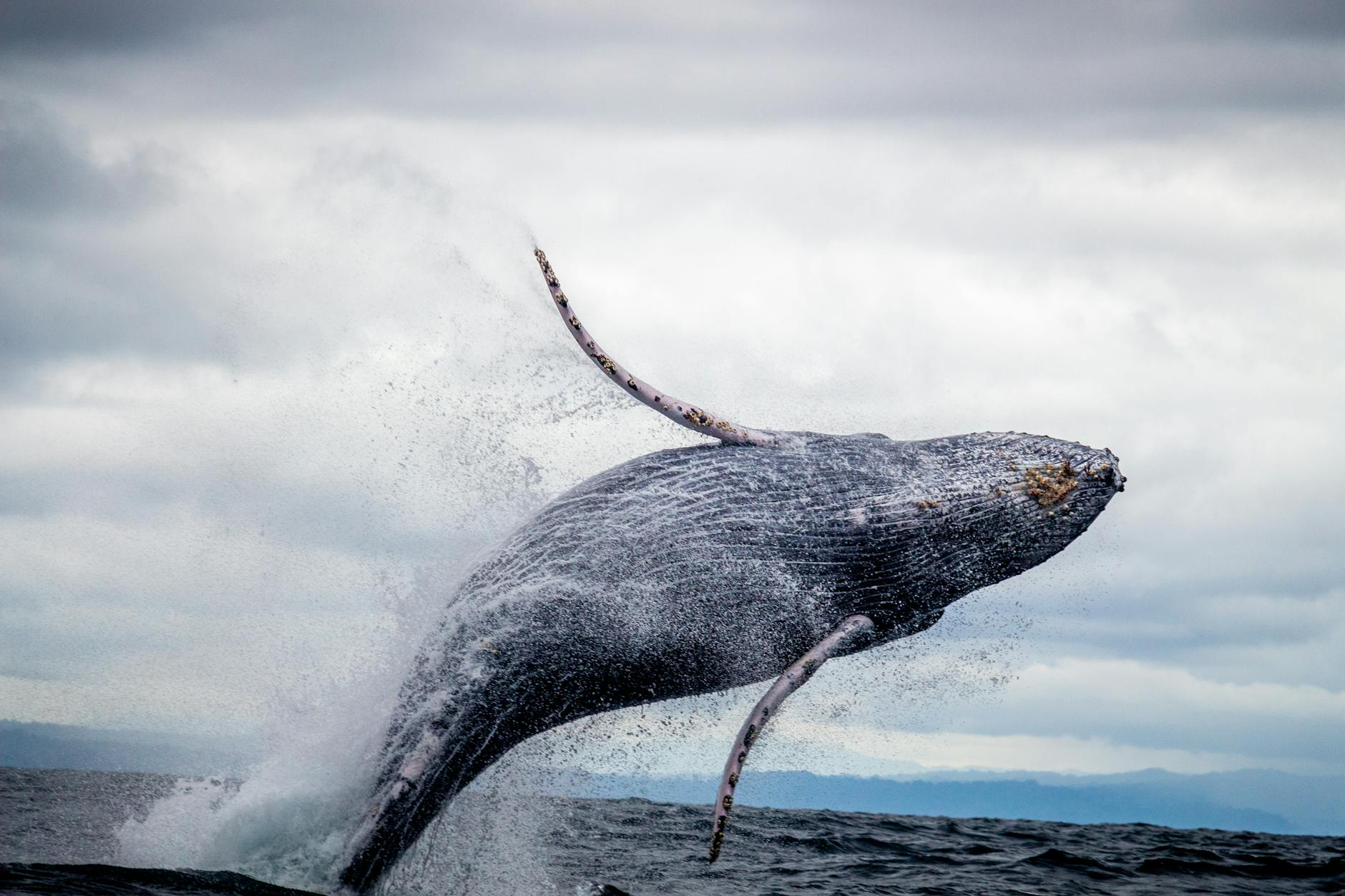How often do whales come up for air? Whales are remarkable creatures adapted to life underwater, yet they, like all mammals, must surface to breathe. This need to come up for air shapes much of their behavior, diving patterns, and survival strategies.
But how often do whales actually come up for air? The answer varies depending on the species, their size, and activity level. This article explores the fascinating breathing habits of whales, explaining how different species manage their need for oxygen and what factors influence their time between breaths.
How Whales Breathe: The Basics
Whales are the largest mammals on Earth, yet we know very little about them. They are totally aquatic and so difficult to observe and study. The most accessible are those that come close to land, such as gray whales.
For most whales, we do not have basic biological information, such as where they go to birth their calves or where their favorite feeding areas are located.
We know that many whales make long migrations from summer feeding ground to winter calving areas, but for most whales, we do not know the routes traveled.
Accurate counts to determine whether whale populations are recovering or shrinking are difficult to gather. These questions and many others are the focus of whale studies today.
Unlike fish, whales are mammals, meaning they breathe air through lungs, not gills. Whales have a blowhole on the top of their heads, which acts as a “nostril” that opens when they reach the water’s surface. To take in oxygen, a whale must surface, expel the used air (producing the characteristic spout), and take in fresh air before diving back down.
The efficiency of a whale’s breathing process is astounding. Whales are capable of exhaling and inhaling in less than two seconds. They can exchange up to 90% of the air in their lungs in a single breath, allowing them to maximize oxygen intake for their time underwater.

How Often Do Whales Come Up for Air?
The frequency with which whales surface for air varies widely depending on several factors, including species, size, activity level, and environment. Here’s an overview of how often different types of whales come up for air:
- Smaller Toothed Whales (e.g., Dolphins and Orcas) Smaller whales, including dolphins and orcas (killer whales), are more active and so need to breathe more frequently. They typically come up for air every 5 to 10 minutes. Yet, when they are highly active, such as when they’re hunting or swimming at high speeds, they may come up even more frequently, every 2–3 minutes. In contrast, when resting, they can hold their breath for longer, often up to 15 minutes.
- Medium-Sized Whales (e.g., Sperm Whales and Pilot Whales) Sperm whales are known for their deep dives in search of food, often hunting at depths exceeding 3,000 feet (900 meters). Sperm whales generally surface for air every 45 minutes to 1 hour, although they are capable of holding their breath for up to 90 minutes. Pilot whales, another medium-sized species, typically come up for air every 10–15 minutes, although they, too, can extend this when diving deeper.
- Large Baleen Whales (e.g., Blue Whales, Humpback Whales, and Fin Whales) Larger whales, like blue and humpback whales, can stay underwater for longer periods thanks to their larger lung capacity. Blue whales, the largest animals on Earth, usually surface every 10 to 20 minutes but can remain submerged for up to 30 minutes when needed. Humpback whales, known for their acrobatic breaches and complex songs, usually come up every 7 to 15 minutes but are capable of staying underwater for around 45 minutes during longer dives.
Factors Influencing How Often Whales Surface
The time between breaths can vary significantly even within a single species. Here are some factors that affect how often whales need to come up for air:
- Species and Size Generally, larger whales with bigger lung capacities can hold their breath longer than smaller whales. This is why blue whales can stay submerged longer than smaller species like dolphins.
- Activity Level Active whales need more oxygen, leading them to surface more often. A whale that is swimming quickly or hunting will need more frequent breaths compared to one that is resting or gliding.
- Dive Depth Whales that dive to great depths, like sperm whales, need more time to return to the surface. These deep-diving species have adaptations that allow them to store more oxygen in their muscles and bloodstream, extending their underwater time.
- Water Temperature In colder waters, whales may have to surface more frequently to regulate their body temperature. In warmer waters, they can conserve energy, potentially extending their breath-hold time.
- Resting State When resting, whales may “sleep” with one hemisphere of their brain at a time, allowing them to remain semi-alert. This resting state reduces their need for oxygen, allowing them to hold their breath longer and surface less often.
How Do Whales Store Oxygen for Long Dives?
Whales have remarkable adaptations that enable them to store oxygen efficiently. Unlike humans, who rely mostly on their lungs for oxygen storage, whales use their muscles and blood as primary oxygen stores.
Whales have high levels of myoglobin, an oxygen-binding protein in their muscles, which allows them to hold onto oxygen for extended periods. Their red blood cells have a high concentration of hemoglobin. That’s enabling more efficient oxygen transport throughout the body.
What Happens When Whales Surface?
When a whale surfaces, it performs a “blow,” expelling a burst of air through its blowhole. This blow is a powerful exhalation that releases warm air from the whale’s lungs. Which condenses into a visible mist as it hits the cooler air above the ocean. Each whale species has a unique blow shape, allowing researchers to identify them from a distance.
After exhaling, the whale quickly inhales fresh air, filling its lungs with oxygen in preparation for another dive. This process of exhalation and inhalation typically takes just a few seconds, making whales incredibly efficient breathers.
5 Interesting Facts About Whale Breathing
- Humpback Whales Can Blow 10–12 Feet High A humpback whale’s blow can reach heights of up to 10–12 feet. This tall mist is visible from afar, helping whale watchers spot them easily.
- Dolphins Surface Every Few Minutes Dolphins are among the most active and curious cetaceans, and they typically surface for air every 3–5 minutes, although they can hold their breath for up to 10 minutes when needed.
- Blue Whales Take Huge Breaths The blue whale, the largest animal on Earth, has a lung capacity of around 1,320 gallons (5,000 liters). That allowing it to stay underwater for up to 30 minutes without needing to resurface.
- Sperm Whales Dive the Deepest Sperm whales dive up to 3,280 feet (1,000 meters) and stay submerged for about 45 minutes on average. They hold the record for the deepest dive among whales.
- Whale Spouts Are Unique Each whale species has a distinct blow shape. Sperm whales, for instance, have a blow that angles forward, while humpbacks produce a taller, vertical blow.
How Long Can Whales Hold Their Breath?
The largest breath-hold capacity varies among species, but some whales have truly impressive times:
- Sperm Whales: Up to 90 minutes
- Beaked Whales: Up to 2 hours
- Blue Whales: About 30 minutes
- Humpback Whales: Around 45 minutes
These times are based on deep, relaxed dives. In most cases, whales surface much sooner, especially when they are feeding or actively swimming.
Why Understanding Whale Breathing Matters
Studying whale breathing patterns helps scientists understand their behavior, health, and adaptability to changing environments. Researchers can track whale migration routes, diving behavior. More responses to environmental stressors like noise pollution or climate change.
Knowing how often whales surface also aids in conservation efforts, allowing authorities to establish safe zones for whale populations near shipping lanes and fishing areas.
Conclusion
Whales come up for air at intervals that vary widely depending on species, activity level, and other factors. Smaller, more active whales like dolphins and orcas surface frequently, every few minutes. Larger whales, such as blue and sperm whales, can hold their breath for extended periods, ranging from 20 minutes to over an hour.
Understanding these patterns sheds light on the incredible adaptations that enable whales to thrive in marine environments. The next time you see a whale surface and blow, you’re witnessing a marvel of mammalian evolution. An animal perfectly designed for a life between two worlds, both above and below the waves.




Pingback: Orca Eyes Everything You Need To Know
Pingback: 5 Facts How Often Dolphins Breathe
Pingback: False Killer Whale Facts, Size & Lifespan